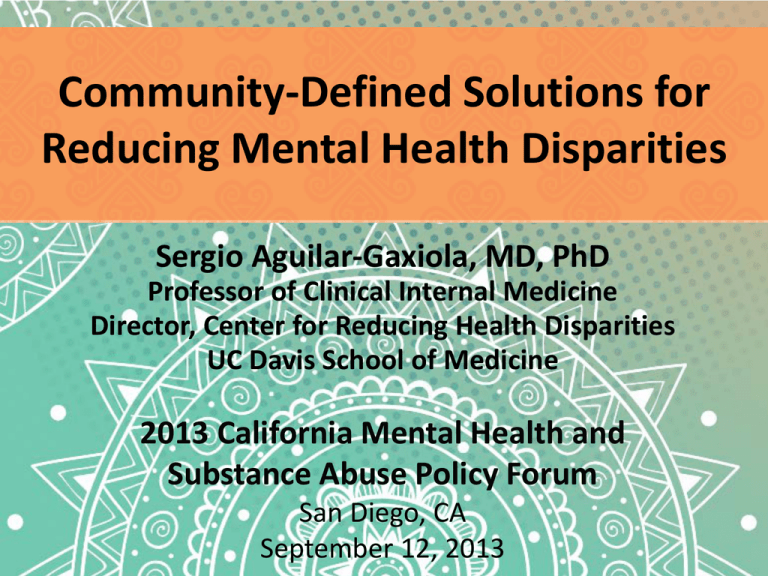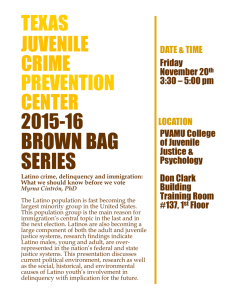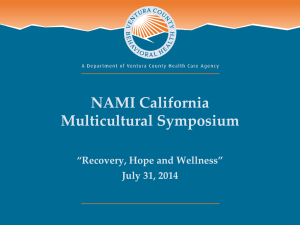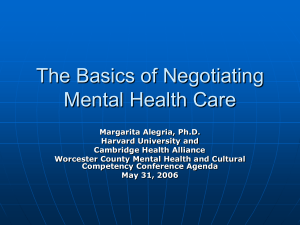Community-Defined Solutions for Reducing Mental Health Disparities Sergio Aguilar-Gaxiola, MD, PhD
advertisement

Community-Defined Solutions for Reducing Mental Health Disparities Sergio Aguilar-Gaxiola, MD, PhD Professor of Clinical Internal Medicine Director, Center for Reducing Health Disparities UC Davis School of Medicine 2013 California Mental Health and Substance Abuse Policy Forum San Diego, CA September 12, 2013 Overview 1. California Reducing Disparities Project 2. Mental Health Care Disparities Among Latinos – Recognizing Barriers in Mental Health among Latinos 3. Strategies to Improve Access to Mental Health Care – Recognizing Strategies to Improve Mental Health Treatment for Latinos 4. Overview of Promising Programs and Practices, and Strategic Directions 5. Implications for Practice The California Reducing Disparities Project Vision: “service delivery defined by multicultural communities for multicultural communities” • This is a key statewide policy initiative to improve: • Access • Quality of care • Positive outcomes for racial, ethnic, and cultural communities • It includes: • Participatory evaluation of community-defined evidence for racial, ethnic, and cultural communities • Identification and roll out of strategies developed across targeted communities to improve outcomes and reduce disparities • Replication of approaches to reduce disparities Moving from Defining Disparities to Seeking New Solutions • Investment in communities most impacted by health disparities. • Supporting “Community Defined Evidence” vs. Adapting and Adopting Evidence Based Practices for California underserved multicultural communities. • A 9 year investment in identifying new community defined approaches to reduce disparities. • Include solutions coming from communities most impacted by disparities. • Willingness to invest in community-based participatory evaluation. • Solutions that are inclusive across the life span. Source: Guerrero, 2009 The Community-Defined Evidence Project (CDEP) • “…a set of practices that communities have used and found to yield positive results as determined by community consensus over time, these practices may or may not have been measured empirically but have reached a level of acceptance by the community.” • The central goal is to develop an evidence-base using cultural and/or community indicators that identify community-defined and community-based practices that work for and matter to these communities. California Reducing Disparities Project: Background In June 2007, the MHSOAC voted to focus on five racial, ethnic, cultural, groups to be included in a Statewide project for Ethnic and Cultural Specific Programs and Interventions. African Americans; Asian/Pacific Islanders; Latinos; Lesbian, Gay, Bi-sexual, Transgender, Questioning youth (LGBTQ); and Native American populations Source: Guerrero, 2009 California Reducing Disparities Project Main goal is to develop a Statewide Comprehensive Strategic Plan. Identify community-defined promising practices, models, resources/approaches helpful for county program planners, practitioners, and policy makers in designing programs to better address the needs of these communities. Contribute culturally relevant recommendations from each ethnic/cultural group to develop a comprehensive statewide strategic plan towards the reduction of mental health disparities Source: Guerrero, 2009 CA Reducing Disparities Project: Latino SPW • The Latino Statewide Reducing Disparities Project started July 1, 2010. • The main goal was to produce a community-defined, strength-based, culturally and linguistically appropriate report on reducing disparities in mental health services for Latinos. • Identified and engaged a diverse range of Latino stakeholder representatives at the state, regional, and local levels. • Stakeholders included consumers, providers, public agencies, and representatives of community interests, and have diversity in terms of gender, age, and mental health and health issues. CA Reducing Disparities Project Latino SPW: Governance and Structure Southern Region (includes LA) Northern California Region The Concilio Bay Area Region Central Region The Concilio The Concilio consists of 31 leaders from across the state. Each Concilio member represents each of the categories previously mentioned. Concilio members range in age, socio-economic status, education, sexual orientation and gender. Concilio members facilitated each forum in their local area and identified individuals, CBOs, etc. to attend. Latino Strategic Planning Workgroup – LATINO CONCILIO Website: http://www.latinomentalhealthconcilio.org Key Issues In Latino Health and Mental Health • The 5 A’s: 1. Accessibility 2. Affordability 3. Availability 4. Appropriateness 5. Advocacy Forum Sites by City, Region & County Exhibit 5: Forum Sites by City, Region, and County CA Reducing Disparities Project: Latino SPW • Each of the community forums had representation from their respective counties in the following categories: Consumer of MH Services Family Members of Consumers MH Providers from CBO MH Provider from Public Sector Promotoras (Community Health Worker) Juvenile Justice System Advocacy Groups Schools Migrant Workers Ethnic Service Managers Others Each forum was organized into 6 Mesas de Trabajo (workgroups) that considered a single issue. 15 Data Collection: Mesas de Trabajo Participants were divided into 6 Mesas de Trabajo. Each group addressed one of the following questions: 1. Strategies for increasing treatment participation of Latinos by reducing individual and community barriers to care (e.g., by reducing stigma, increasing family and community support for mental health). 2. Strategies for increasing treatment participation by improving access to existing programs and services. 3. Recommendations for new programs and modification of services delivery to increase treatment participation. 4. Recommendations for new programs and modification of services delivery to increase retention in services and reduce dropout. 5. Recommendations for new programs and modification of existing services to improve successful treatment outcomes (other than retention). 6. Strategies for design of effective approaches to the evaluation of implemented recommendation. California Reducing Disparities Project Full report (PDF) available at: http://www.latinomentalhealthconcilio.org/mhsa/crdp-latino-population-report/ Spanish version will be soon available Three Major Types of Barriers 1. Individual-Level Barriers – – – – – Sigma Culture Gender (masculinity) Violence and trauma Knowledge and awareness 2. Community-Level Barriers – – – – Lack of culturally and linguistically appropriate services Shortage of bilingual and bicultural mental health workers Lack of school-based mental health programs Organizational and systemic barriers 3. Systemic-Level Barriers – Lack of social and economic resources and poor living conditions – Inadequate transportation – Social exclusion Barriers to Care Indicators Type of barrier… Indicators of barriers Individual-Level Negative perceptions about mental health care as a significant factor contributing to limited or no access to care. Among the many concerns, stigma, culture, language, gender role expectations, exposure to violence, and lack of information and awareness were the most common Community-Level The critical shortage of mental health facilities and general practitioners and specialized providers, especially in underserved areas. Also, lack of culturally and linguistically relevant services to increase Latinos’ service utilization and treatment effectiveness Systemic-Level (social determinants) The physical geographic isolation and dispersion of Latino subgroups such as migrant workers often results in a lack of service opportunities. Also, lack of transportation and economic resources (e.g., health insurance) contribute to disparities Strategies to Improve Access to Mental Health Care Strategies to Improve Access, Availability, Appropriateness, Affordability, and Advocacy • Community and Cultural Assets • Community-Identified Strategies (Prevention & Early Intervention) • Individual and community resiliency • School-based mental health programs • Family involvement • Church and religious leaders • Community role models and mentors • Community Pláticas (social conversations) • Community-based organizations and co-location of resources • Community media • Culturally and linguistically appropriate treatment • Workforce development to sustain culturally and linguistically competent workforce • Community outreach and engagement Community and Cultural Assets Individual and Community Resiliency Familismo (family) Confianza (trust) Protective factors: Latino cultural core values Respeto (respect) Personalismo (relationships) • Latino community leader: “We need to focus on strategies that empower community groups at the local level ... encouraging Latino individuals and communities to grow and change according to their needs and priorities” Church and Religious Leaders Promote Wellness - Education - Sermons Church/Religious Leaders Build Knowledge - Train/educate - Reduce stigma Build on Reciprocal Relationship Mental Health Latino Communities Demonstrate Prevention - Increase knowledge - Increase access and retention Strengthen Partnerships - Starting point - Trust (confianza) Community Role Models and Mentors: Promotoras Community Pláticas • Community Pláticas are used in support groups composed of Spanish-speaking people with similar experiences and well-informed community leaders (e.g., promotoras/es) • Participants also expressed the value of Pláticas that incorporate the testimonials of Latino consumers with successful recovery stories as an inspiration and sign of hope Community-Identified Strategies (Prevention and Early Intervention) School-Based Mental Health Programs • Study participants emphasized the importance of building partnerships with schools and noted that schools are easily accessible and convenient for both mental health treatment and prevention programs. • Study participants emphasized the importance of family support and involvement in a school context as a strategy to educate Latino families and communities about mental health services. Prevention and Latino Adolescents: Changing the Course of a Mental Disorder Community-Based Organizations and Co-Locating Resources • Co-location is an approach that integrates mental health services into primary care as a pathway to improving access to and utilization of mental health services • Co-location enables organizations to localize and collaborate and share resources to better serve the Latino community • This type of collaboration will reduce the long waiting lines for mental health services, and increase the likelihood that Latino consumers and their families will use and adhere to their mental health treatment at their point of entry into the health system (NIHCM, 2009) Community Media • Communication media to educate Latinos about mental health services – Remove barriers to care – A mechanism to reach out to more Latinos • Media sources – – – – – Newspaper Radio Television Social media Fotonovelas (media booklet) Fotonovelas Culturally and Linguistically Appropriate Treatment What are FIVE Important Elements of Cultural and Linguistically Appropriate Treatment? Organizational 1. 2. 3. 4. 5. Values diversity Integrates cultural knowledge of the Latino experience Adopts and adapts to Latinos’ cultural values and beliefs, life experiences, and family practices Assesses providers’ abilities to deliver appropriate treatment to Latinos Provide cultural and linguistic competence training program to providers Individual (Provider) 1. 2. 3. 4. 5. Knowledge and commitment to diversity Acknowledges culture and life experiences of Latinos Possesses sense of purpose consistent with Latino culture Self-assess cultural knowledge and the need to stay current Demonstrates empathy, flexibility, humility, genuineness , justice, and joy when serving Latinos Community-Defined Strategies and Solutions Strategies to Improve Access Community and Cultural Assets Community-Identified Strategies Core Community-Identified Strategies to Improve treatment Peer-to-peer strategies Strategic Directions & Recommendations for Reducing Disparities Family psycho-education Wellness & illness management Academic and school-based programs Community capacity-building Co-locating services Educational campaigns Community and social media Best practices in integrated Workforce development services Culturally & linguistically appropriate services Community capacity-building, outreach and engagement MHSA funded programs Community-Defined Evidence Programs and Practices Community-Defined Evidence Based Programs and Practices Capacity building Raising public awareness Seven-item criteria to identify promising programs and practices: Community outreach Increasing service accessibility Innovative engagement practices Localization of services and practices Appropriate interventions and treatments Communitydefined evidence programs and practices Community-Defined Evidence: Examples of Promising Programs and Practices for Latinos Latino SPW Matrix of Organizations with Community-Defined Evidence Programs Community-Defined Evidence: Examples of Promising Programs and Practices for Latinos Latino SPW Matrix of Organizations with Community-Defined Evidence Programs Implications for Practice • Invest in integration of mental health services and primary care while at the same time building capacity and workforce diversity in Latino communities • Build on community assets through collaboration between state and local public and private agencies can ensure that all Latinos have equal access to affordable and culturally and linguistically appropriate care • Evaluation and data collection should be strengthened to better assess the reduction of mental health disparities and the effectiveness of community-defined evidence practices for Latinos from different backgrounds • Community outreach and engagement and social media should be used to promote prevention and wellness • MHSA and Affordable Care Act resources should be targeted to un/underserved Latino consumers and their families. Conclusion • As the California’s population continues to become increasingly diverse, the passage of the health care reform law becomes critically important in advancing health equity for racial, ethnic, language, gender, and LGBTQ diverse populations • More must be done to recognize and address other areas necessary to reshape health care and reduce disparities. Necessary changes include more: – Health equity initiatives in prevention and early intervention – Workforce diversity – Cultural and linguistic competence among health care workers – Accountability: data collection and serious monitoring of progress – Access to high-quality care Acknowledgments We are very grateful to the many participants who shared their experiences, observations and personal stories. We hope that their voices have been well represented. A special appreciation to the County Ethnic Service Managers and local community leaders who helped us connect to the local communities. A heartfelt thank you for the involvement, ongoing input, guidance, time and effort of all and each of the Concilio members. Un agradecimiento muy especial a Gustavo Loera, EdD, Lina Mendez, PhD, Marbella Sala y Lisa Stenhouse-Gaskin Acknowledgments Rachel Guerrero, Independent Mental Health Consultant and past Director, California Mental Health Office of Multicultural Services Marina Augusto, Interim Director and Kimberly Knifong, California Department of Public Health Office of Health Equity With Contributions From: The Latino Mental Health Concilio County Mental Health Ethnic Managers Forum Participants: Individuals, communities, and organizations across California With Generous Support From: California Department of Public Health UC Davis Center for Reducing Health Disparities CA Reducing Disparities Project PLEASE VISIT OUR WEBSITE AT: http://www.latinomentalhealthconcilio.org/ 43


